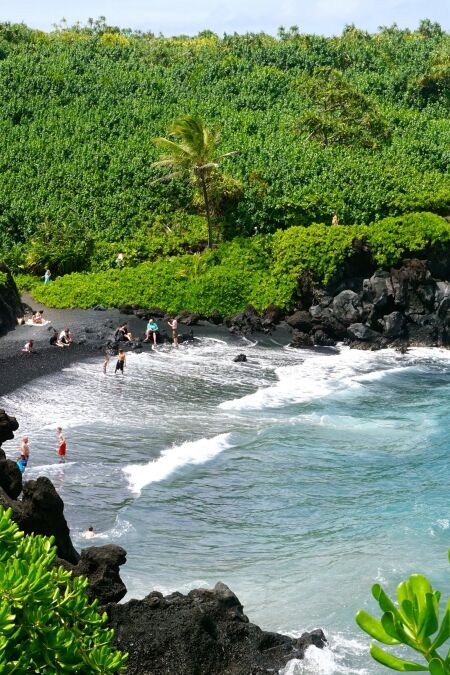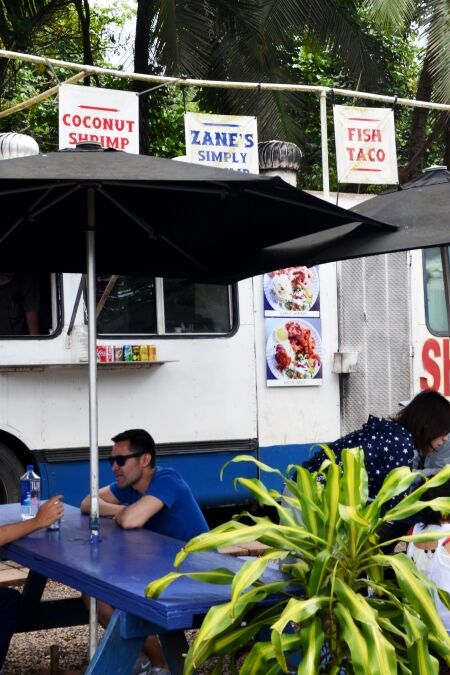Known for its breathtaking landscapes and cultural importance, the Road to Hana is an adventure into the heart of Hawaii’s natural beauty. This guide offers invaluable tips for navigating the route, highlights the must-see stops, and uncovers hidden gems along the way, ensuring your trip is as unforgettable as the scenery.
Highlights
- Find numerous waterfalls, each offering unique beauty. Notable stops include Twin Falls, the easily accessible Wailua Falls, and the majestic 400-foot Waikani Falls.
- Hiking trails off the road lead into serene settings, perfect for nature lovers.
- This park features a striking black sand beach, sea caves, and natural stone arches, making it a great spot for photography and relaxation.
- Roadside stands along the route offer the chance to sample fresh local fruits, banana bread, and other Hawaiian delicacies, providing a taste of local culture and cuisine.
- Explore local shops, eat at local restaurants, and soak up the peaceful atmosphere.
History
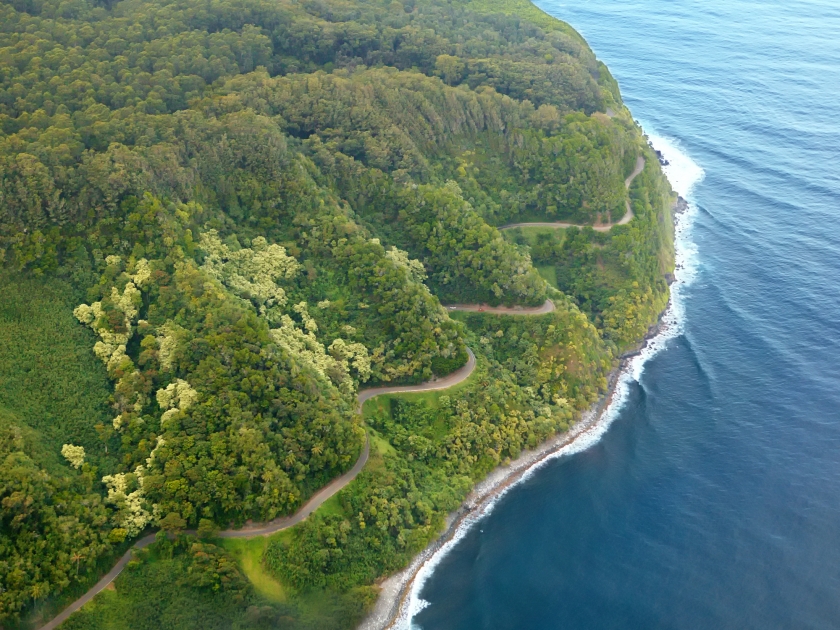
From Ancient Trails to a Tourist Haven
The Road to Hana, a renowned scenic drive on Maui, boasts a storied past that traces back centuries. The earliest known path was the Alaloa, constructed in the 16th century under the reign of King Piʻilani. This extensive footpath, initially used by locals who navigated its challenging terrain with vine ropes to ford streams, was later extended by his son towards Hana, enhancing connectivity across the island.
The Sugarcane Influence
By the 1870s, the landscape of Maui began to transform significantly with the sugarcane boom. Modern road construction commenced to facilitate the Hāmākua Ditch project, which was instrumental in irrigating the vast sugarcane fields in central Maui. This era marked a pivotal shift in the region’s economic landscape, intertwining the road’s development with the agricultural prosperity of the island.
Contribution of Convict Labor
The road’s development was sporadic and arduous in the early 20th century, often relying on convict labor. Prisoners were enlisted to help build sections of the road, a common practice at the time that slowly pushed the infrastructure toward completion.
Official Completion and Continued Expansion
The Road to Hana was officially completed in 1926, heralding a new era of accessibility for the region. However, the infrastructure work didn’t stop there; the construction of bridges continued well into the 1930s, further solidifying the road’s capacity to support increased traffic and tourism.
The Road Today: A Paved Paradise
It wasn’t until the 1960s that the Road to Hana was fully paved, transforming it into the scenic drive celebrated by tourists today. This modernization enhanced its appeal, making the journey smoother and more accessible for visitors eager to experience Maui’s breathtaking landscapes and rich history.
Key Stops Along the Road to Hana
Waterfalls
Twin Falls
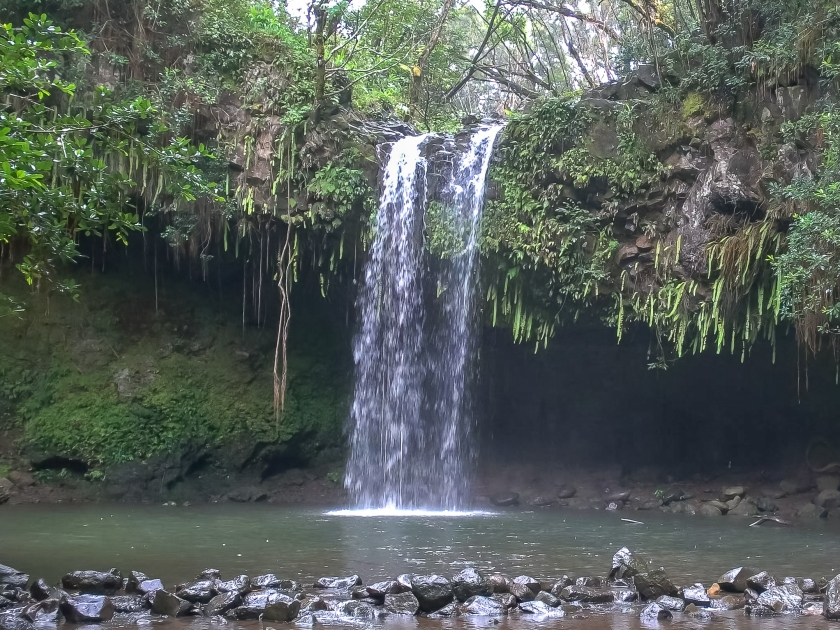
Twin Falls marks one of the first and most accessible waterfalls on the Road to Hana. It’s a favorite for its easy trail and picturesque setting, ideal for a quick swim or photo op against the backdrop of cascading waters surrounded by lush greenery.
Waimoku Falls
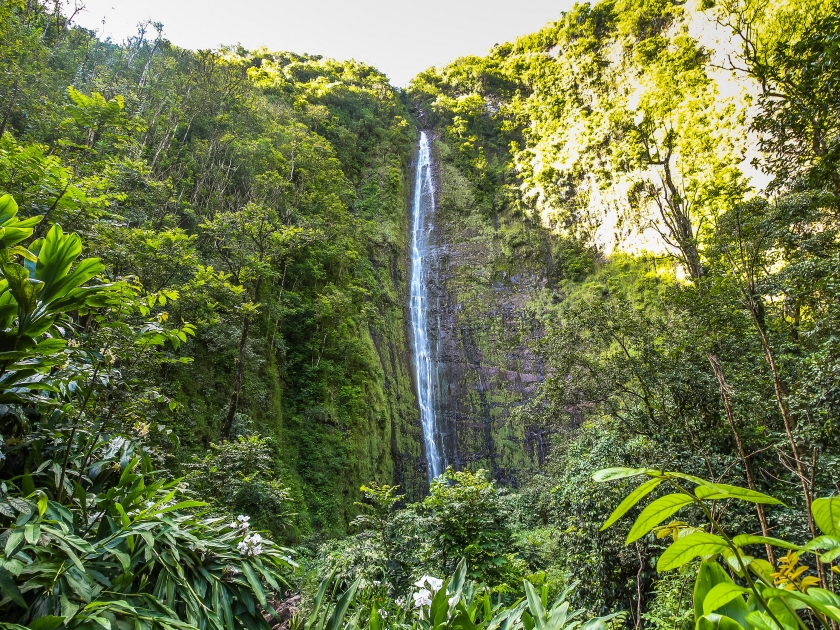
Located at the end of the Pipiwai Trail, Waimoku Falls is an impressive 400-foot-high waterfall that provides a stunning climax to a scenic hike through bamboo forests and past smaller cascades. The trail and the falls offer a rewarding experience for those willing to venture a bit off the beaten path.
Waikani Falls
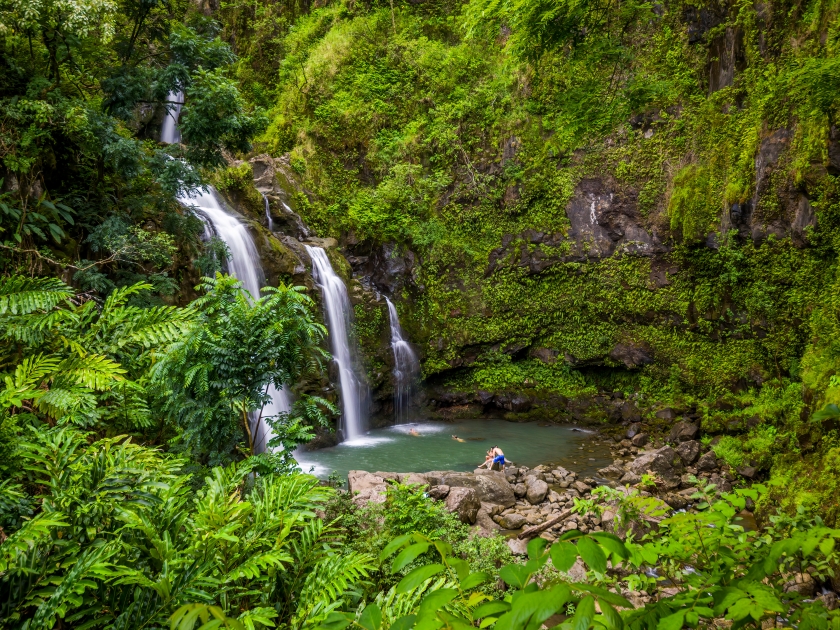
Commonly known as the “Three Bears Falls,” Waikani Falls features three parallel streams that drop beautifully into a pool, making it a photogenic stop along the Hana highway. Easily viewed from the road, it’s perfect for a quick stop to enjoy the powerful sight and sound of nature.
Wailua Falls
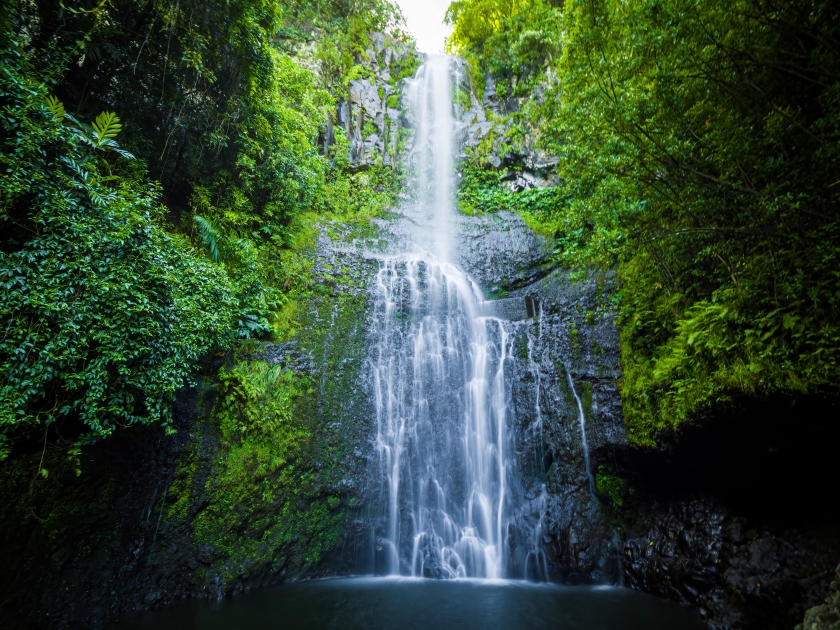
Wailua Falls is one of the most accessible and remarkable waterfalls along the route. This 80-foot-tall waterfall is visible from the road and offers a dramatic photo opportunity without the need for a hike, making it ideal for those who want to experience the majesty of Hawaiian waterfalls with minimal effort.
State Parks
Kaumahina State Wayside Park
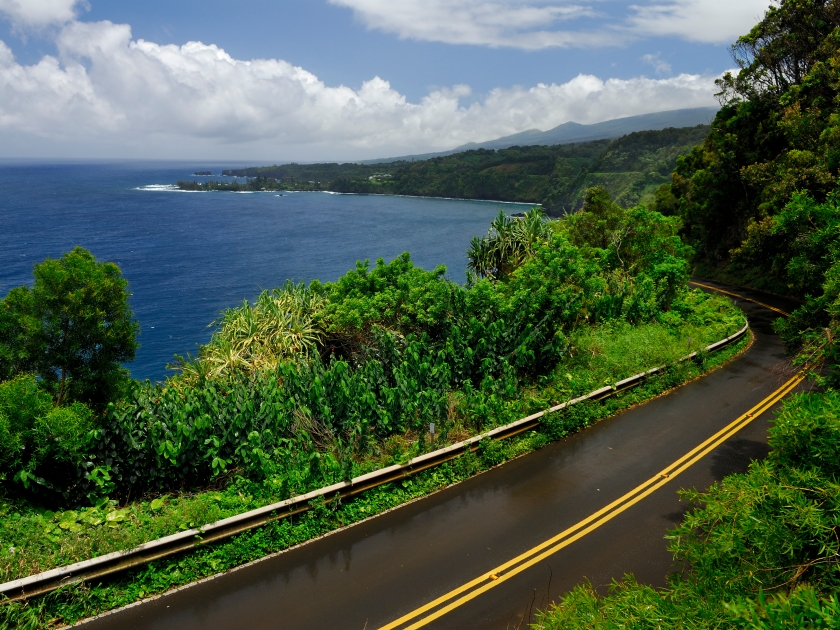
Kaumahina State Wayside Park provides expansive views of the northeastern Maui coastline and the lush Ke’anae Peninsula. With picnic areas and restrooms, it’s a convenient stop to stretch your legs and enjoy the vibrant greenery and ocean vistas.
Waianapanapa State Park
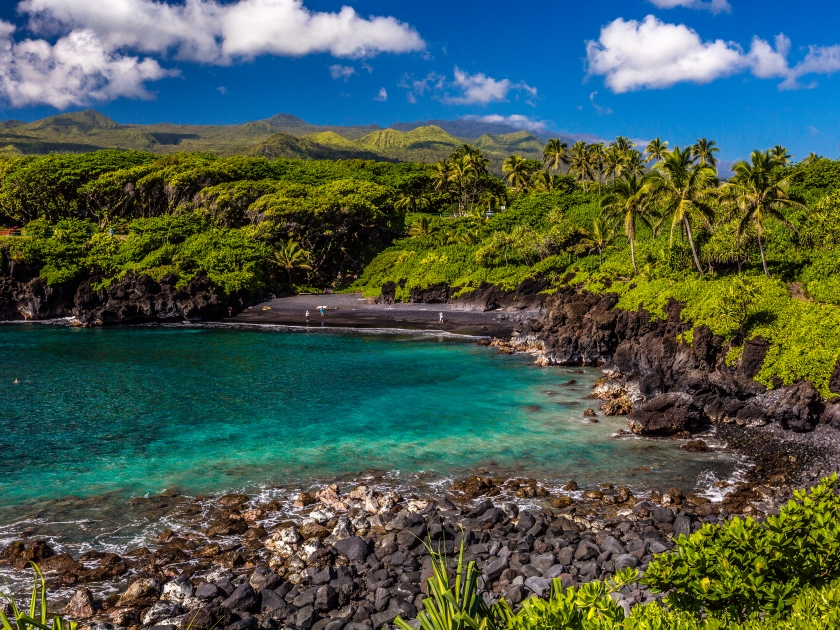
Waianapanapa State Park is a must-visit, renowned for its stunning black sand beach, ancient lava tubes, and freshwater caves. Whether you’re up for a swim, a walk along the coastal trails, or simply soaking in the dramatic scenery, this park is a cornerstone of the Hana experience.
Wailua Valley State Wayside Park
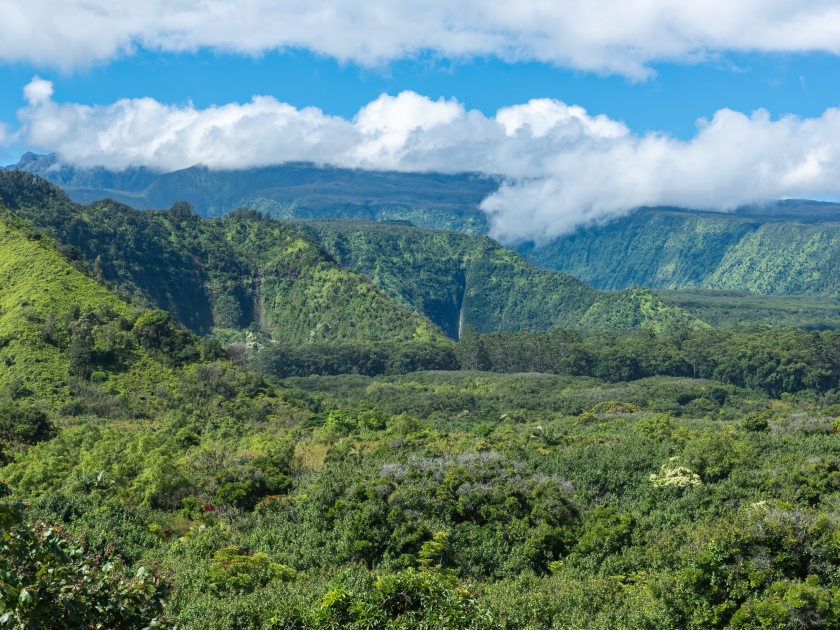
Overlooking the lush Wailua Valley, this park offers a panoramic view of the valley floor dominated by traditional taro patches and surrounded by dense rainforest. It’s a quick stop that provides a significant glimpse into rural Hawaiian life and the island’s agricultural tradition.
Hookipa Beach Park
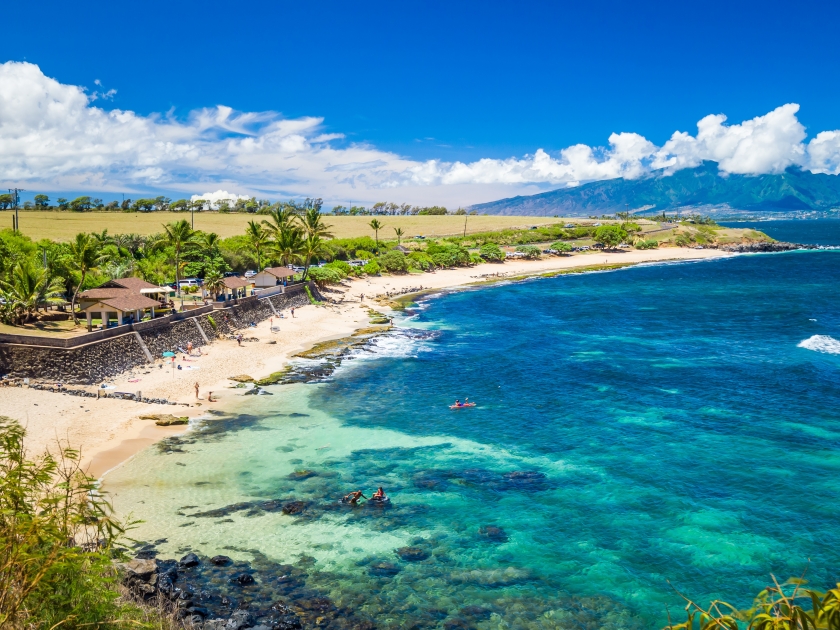
Hookipa Beach Park is a world-famous windsurfing and surfing destination known for its impressive waves and skilled riders. Even if you’re not there to catch the waves, it’s thrilling to watch the action from the overlook or relax on the sand and enjoy the ocean breeze.
Beaches
Waianapanapa Black Sand Beach
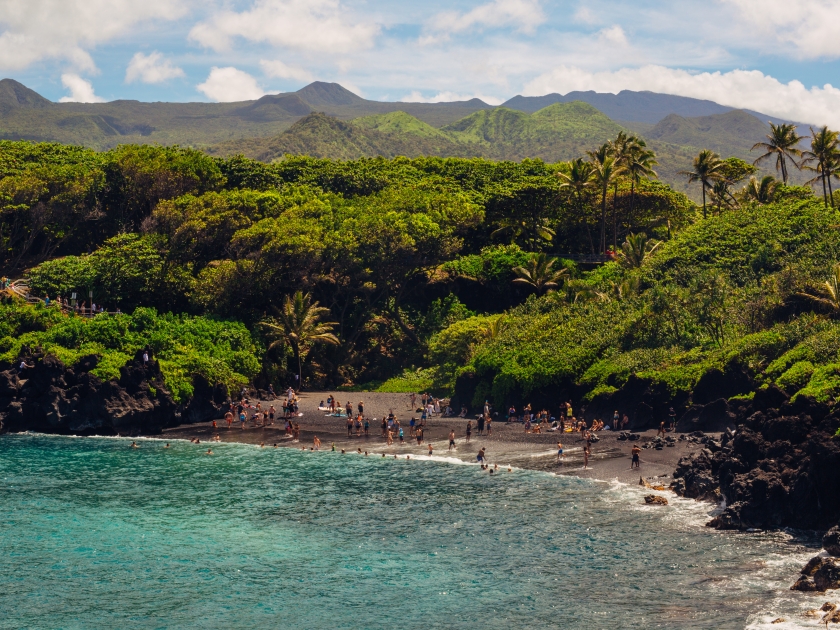
The unique black sand of Waianapanapa Black Sand Beach is created by volcanic activity, offering a striking contrast to the blue waters and lush green flora. This beach isn’t just for sunbathing; it’s a hub for exploring sea caves, hiking trails, and ancient Hawaiian burial sites.
Keanae Peninsula
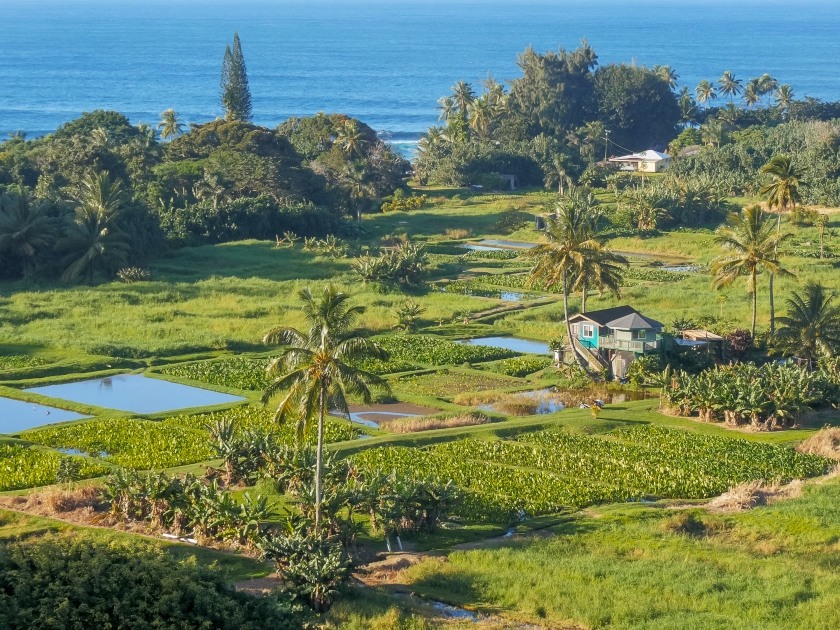
The Keanae Peninsula offers a rugged and less frequented spot along the road, ideal for those seeking a peaceful retreat. The area is characterized by its dramatic lava rock coastline and offers a great spot for powerful ocean photography and contemplative moments away from the crowds.
Red Sand Beach
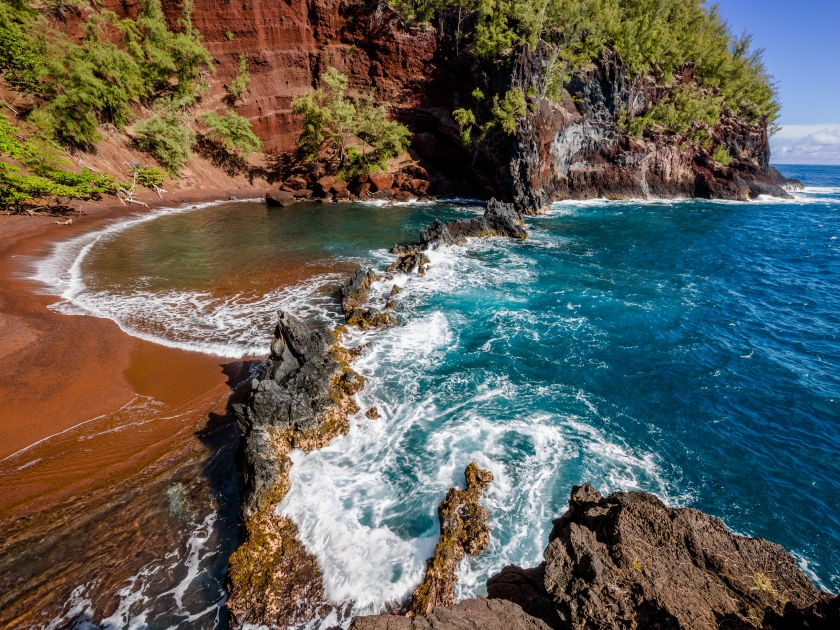
Red Sand Beach, or Kaihalulu Beach, is a hidden gem nestled in a secluded cove near Hana. Its striking red sand, a result of the crumbling cinder cone surrounding the bay, contrasts dramatically with the turquoise waters. This beach offers a sense of privacy and isolation, ideal for those looking to escape the more crowded spots, but visitors should tread carefully due to the steep and slippery path leading down to the beach.
Other Locations
Hana Bay
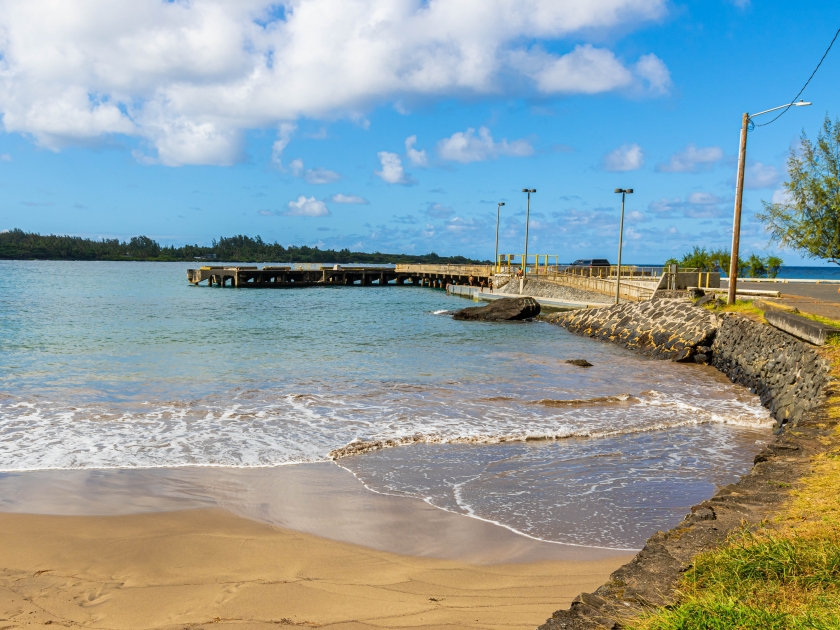
Hana Bay is a picturesque, sheltered bay perfect for a leisurely swim or a picnic with views of the tranquil waters and surrounding forested hills. Its calm waters make it an excellent spot for families or anyone looking to unwind after the scenic drive.
Hana Lava Tube
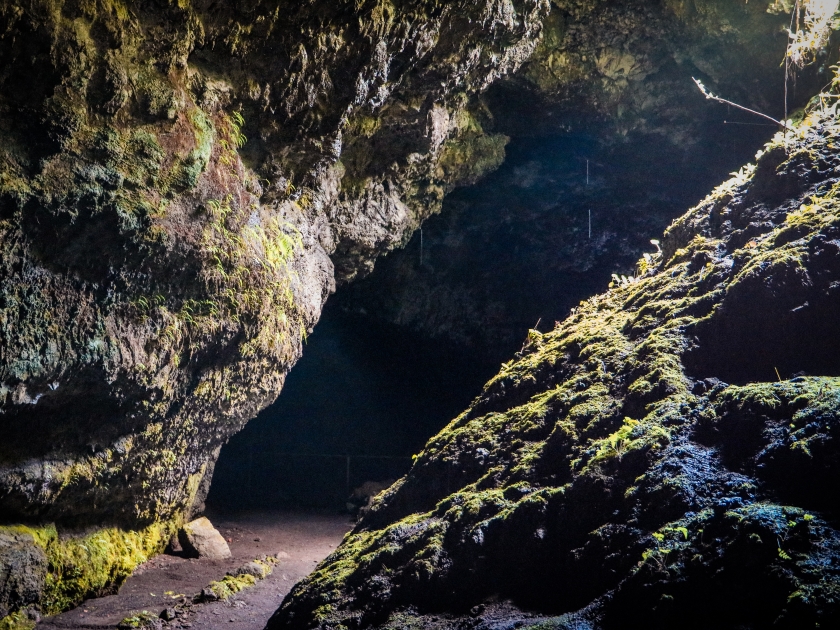
Explore the Hana Lava Tube for a fascinating journey into Maui’s geological past. This easily accessible lava tube allows visitors to walk through a subterranean tunnel formed by molten lava, highlighted by informative displays and even some resident bats.
Bamboo Forest
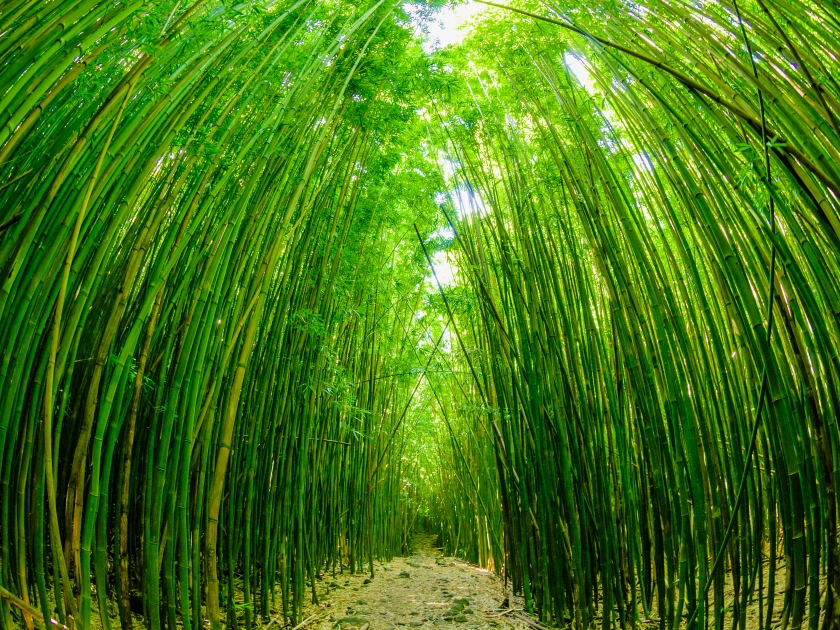
The Bamboo Forest along the Pipiwai Trail is a serene escape into a different world. As you hike through the towering bamboo stalks that clack together in the wind, the outside world seems to disappear. This lush green corridor, leading up to the majestic Waimoku Falls, offers a tranquil and somewhat mystical hiking experience, perfect for nature lovers and photographers alike.
Paia Town
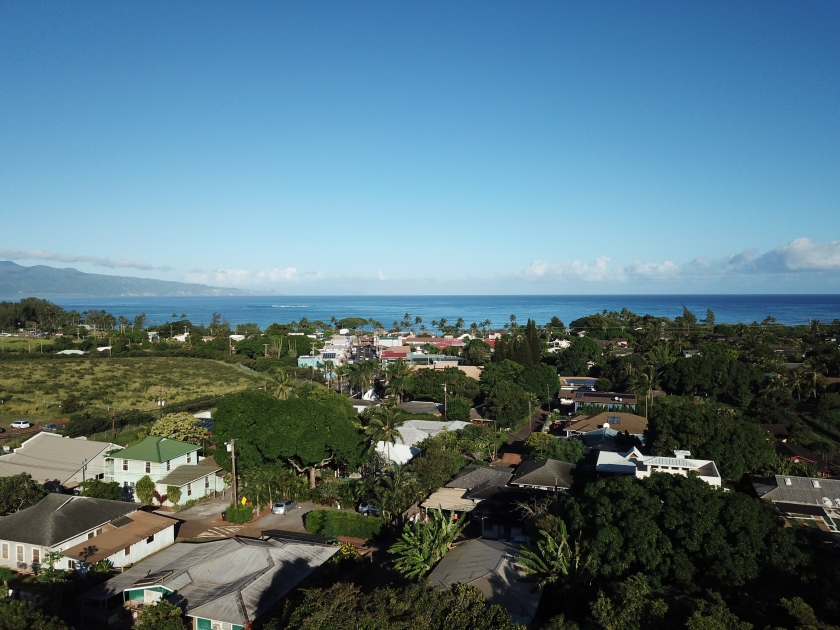
Paia Town is the quintessential Hawaiian small town with a bohemian vibe, filled with eclectic shops, cafes, and galleries. It’s a great place to pick up unique souvenirs, sample local food, or just soak up the laid-back atmosphere at the start of your Road to Hana journey.
Hana Town
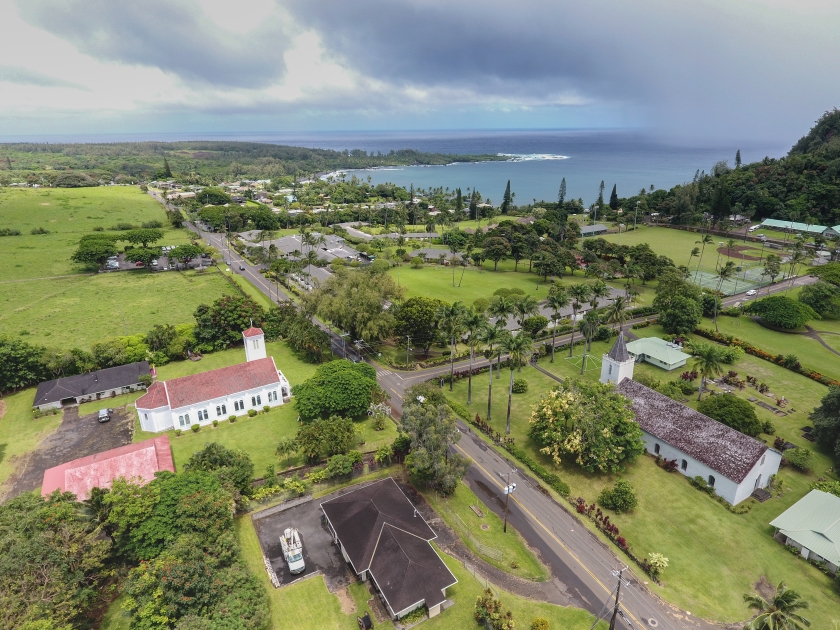
As the endpoint of the Road to Hana, Hana Town offers a serene environment steeped in Hawaiian culture and history. Take your time to explore the local shops, enjoy a meal of traditional Hawaiian cuisine, and experience the warm hospitality of its residents.
Things to Do
Sightseeing Tour
Embark on a sightseeing tour along the Road to Hana to witness some of Maui’s most breathtaking landscapes. This journey offers an abundance of scenic lookouts, waterfalls, and coastal views. Guided tours are available for those who prefer an informed narrative of the area’s history and geology, ensuring you don’t miss any of the road’s famous landmarks.
Rainforest Tour
A rainforest tour immerses you in the lush, verdant landscapes that define much of the Hana highway. These tours often include guided walks through dense foliage where you can learn about the local flora and fauna. It’s an educational and exhilarating experience that highlights the ecological diversity of Maui’s tropical rainforest.
Hiking the Road to Hana
Hiking along the Road to Hana offers an intimate encounter with Maui’s spectacular natural landscape. The route features several trails, ranging from easy walks to more challenging treks, that lead through lush rainforests, past cascading waterfalls, and to panoramic vistas. Key trails like the Pipiwai Trail to Waimoku Falls provide a rewarding journey through a bamboo forest ending at a stunning waterfall.
Kayaking
Kayaking along the coast near Hana provides a peaceful and intimate way to explore Maui’s pristine waters. Paddle through calm bays and hidden coves, possibly spotting sea turtles and colorful fish beneath the surface. This activity offers a quiet retreat from the busier tourist spots, allowing for close encounters with nature.
Snorkeling
Snorkeling in the clear waters of Maui is a must-do for marine life enthusiasts. Discover vibrant coral reefs teeming with diverse aquatic species. Organized tours can take you to some of the best snorkeling spots, where the water is alive with an array of tropical fish and other sea creatures.
Haleakala Helicopter Ride
Experience the majestic beauty of Maui from the sky with a helicopter ride over Haleakala. This tour offers stunning aerial views of the massive volcano, its surrounding national park, and parts of the Road to Hana that are inaccessible by car. It’s a breathtaking way to witness the island’s dramatic landscapes and volcanic features.
Tips for Visiting
- Start Early: Begin your journey early in the morning to avoid heavy traffic and to have more time at each stop.
- Plan Your Route: Decide in advance which stops you want to make to ensure you don’t miss your must-see attractions.
- Bring Supplies: Pack water, snacks, sunscreen, and a first-aid kit, as services along the Road to Hana are limited.
- Wear Comfortable Clothing: Dress in layers and wear comfortable shoes suitable for hiking and walking.
- Check Weather Conditions: The weather can change quickly; check forecasts and prepare for rain, especially in lush areas.
- Respect Local Guidelines: Follow any posted signs, stay on marked trails, and respect private property and local communities.
- Leave No Trace: Keep the environment clean by packing out all your trash and minimizing your impact on natural sites.
- Fuel Up: Make sure your vehicle has a full tank of gas before you start, as there are few fuel stations along the route.
- Download Maps: Cell service can be spotty, so download maps or directions ahead of time for offline access.
- Take Your Time: The Road to Hana is more about the journey than the destination; don’t rush, and enjoy the varied landscapes and stops along the way.
Best Times to Visit
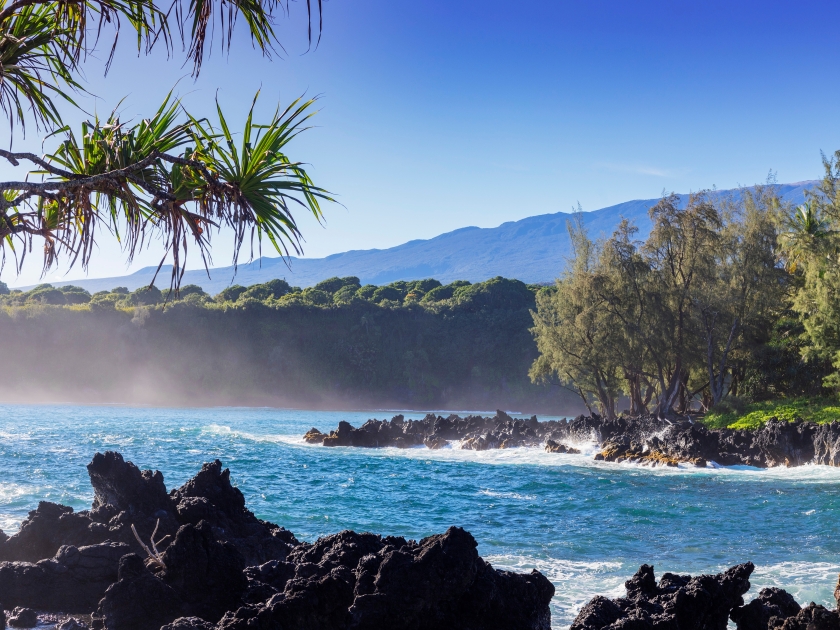
The best times to visit the Road to Hana are during the spring (April and May) and fall (September and October) months. During these periods, the weather is typically milder and the rainfall is less frequent, making road conditions safer and more comfortable for travel. Additionally, these off-peak seasons often mean fewer tourists, allowing for a more relaxed experience at popular stops and attractions. However, no matter when you choose to go, the Road to Hana offers breathtaking views and a rich exploration of Maui’s natural beauty.
Frequently Asked Questions (FAQs)
The Road to Hana is a scenic drive through Maui, Hawaii, known for its lush landscapes, waterfalls, and ocean views.
It typically takes about 2.5 to 4 hours to drive the Road to Hana without stops. However, with stops, it can take a full day.
Key stops include Twin Falls, the Garden of Eden Arboretum, Wai’anapanapa State Park, and Hana Town.
The road is narrow and winding with over 600 curves and 50 bridges, requiring careful driving, but it is safe with cautious driving.
Yes, you can drive a rental car on the Road to Hana, but check your rental agreement for any restrictions regarding unpaved roads.
It’s best to start early in the morning, around 7 AM, to avoid crowds and ensure you have enough daylight to enjoy the sights.
How to Get There
By Car
Driving to the Road to Hana offers the flexibility to explore at your own pace. Start your journey in Kahului, ensuring you’ve rented a car with good mileage as it’s about a 64-mile drive. Head east on Highway 36, which becomes Highway 360, leading directly to Hana. The road is winding and narrow, so drive cautiously and take your time to enjoy the scenic views, waterfalls, and beaches along the way. Remember, it’s more about the journey than the destination, so plan for a full-day trip.
By Bus
For those preferring not to drive, bus tours are available and provide a stress-free way to experience the Road to Hana’s beauty. These tours often include commentary, providing insights into the area’s history and culture. Various companies offer day trips from Kahului or other parts of Maui, including stops at popular landmarks. Booking in advance is recommended, especially during peak tourist seasons.
Journey Along the Road to Hana!
As you plan your adventure on the Road to Hana, remember to embrace the journey at your own pace and absorb the stunning natural beauty around every turn. To make the most of your trip, consider using the tips provided and explore options for guided tours and local accommodations to enhance your experience. For convenient booking of tours and stays, visit HawaiiActivities.com, where you can find a variety of curated experiences tailored to your interests along the Road to Hana.


